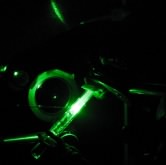The Role of Spectroscopy in Inorganic Chemistry

This page is designed to list the important roles that spectroscopy plays in the field of inorganic chemistry. Please be specific and include examples from the literature if possible. Remember that this is an interactive page and that all members of the course should be participating! You should consider this page as your first introduction to the use of the wiki environment so play around, include some links (for references), some graphics, an equation maybe?
Remember to use the 'discussion' page (see tabs above) to discuss items before finalizing them on this page. Also remember that Pierre will be tracking who inserts what on this page, and this information will be used (qualitatively) to help determine the participation part of your mark for Chem 529.
--Pierre 16:54, 5 January 2010 (UTC)
The role of spectroscopy in Inorganic Chemistry
(Generally, spectroscopy can be used to characterize inorganic materials in various ways. Such as:
- Determination of geometric structure of inorganic compounds.
- Determination of electronic structure of inorganic compounds.
- Determination of the elemental composition of a sample.
- Determination of protein secondary and tertiary structure.
- Determination of kinetic parameters during a reaction.
- Determination of relative concentrations of different species present at any time during a reaction.
- Determination of the functional groups of a compound.)
Some examples of the use of spectroscopy in Inorganic Chemistry
((
Elucidation of structure
- NMR: indicates degree of symmetry of a ligand around a metal center as well as the electron environment of the nucleus being probed.
- Mass spectrometry: mass of compound, composition of a compound or mixture of compounds
- EPR: determination of properties and spin resonance of paramagnetic metal complexes.
- Linear Dichroism: provide orientation data of anisotropic inorganic materials.
- Circular Dichroism: provides fingerprint information for the structure of various large biological molecules such as peptides (which can be coordinated with metals)
- NMR: J-coupling constants are used to derive to dihedral (torsion) angles and therefore enable determination of protein structure
- IR/UV-Vis/Raman: can be used to identify certain functional groups in a sample
- UV-Vis Spectroscopy: Used to determine electronic structure of compounds (Band structures)
- X-Ray Crystallography: can be used to elucidate structure of crystalline materials
- NMR Titrations: can be used to track variations in structure (nmr signal) under the influence of some external stimulus (pH for example)
- Atomic Absorption Spectroscopy: Analysis of the concentration of a metal element.
Kinetics
- IR, UV-Vis and Raman spectroscopy: can all be used to monitor kinetics by tracking a molecular vibration which is unique to either the product, or reactant.
- NMR can also be used in kinetic studies.
- Auger electron spectroscopy: A surface specific technique used to determine the composition of the surface layers of a sample.
- Energy Dispersive X-Ray Spectroscopy: Typically used in conjunction with scanning electron microscopy to characterize the elemental composition of a sample.
- Moessbauer Spectroscopy: Helps determine electron configuration
- NMR: can be used to monitor the reaction by the analysis of nuclei other than 1H and 13C
- Fluorescence spectroscopy: used to measure the fluorescence of a sample
))